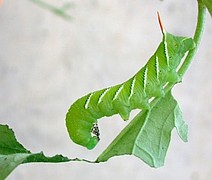NATURE publication:
Research scientists discover new production pathway for plant SOS signals [02.01.18]
Uni Hohenheim and the National Center for Biotechnology in Madrid discover previously unknown pathway for jasmonate formation / Publication in Nature Chemical Biology
Nibbling prohibited: when harmful insects attack a plant, it defends itself. It forms protective substances that are poisonous for the insects. This defense response is activated by messengers, jasmonates. Their biosynthesis had been deemed to have been elucidated for almost two decades. But now plant physiologists from the University of Hohenheim in Stuttgart and the National Center for Biotechnology (CNB-CSIC) in Madrid have found an alternative synthesis pathway for jasmonates. This means that plant physiologists will now have to rethink many explanations of resistances and hormonal activity. The researchers have published their findings in the scientific journal Nature Chemical Biology: dx.doi.org/10.1038/nchembio.2540
These substances control the defense response of plants to insects and other harmful organisms and they steer pollen development, for instance. Jasmonates are phytohormones and are present in almost all plants. “The question as to how jasmonates are formed in plants is actually deemed to have been clear for a long time now,” reported Professor Andreas Schaller, Head of the Department of Plant Physiology and Biotechnology at the University of Hohenheim.
In 2000 and 2001, the Hohenheim plant physiologist Dr. Annick Stintzi discovered the last missing link in the biosynthesis pathway. The research team published its findings at that time in two articles in the scientific journal Proceedings of the National Academy of Sciences (PNAS). Both met with considerable international recognition.
But one thing remained a puzzle. With increasingly sensitive measurement techniques, they discovered that the mutants of their model plant thale cress (Arabidopsis thaliana), which have a genetic defect in the known biosynthesis pathway, are also capable of forming jasmonates. “So there had to be an alternative to the known synthesis pathway,” explained Professor Schaller.
Bypass circumvents known jasmonate synthesis pathway
Together with Sally Weiss, a doctoral candidate at the University of Hohenheim, and her lead cooperation partner in the project, Professor Solano and his team at the National Center for Biotechnology (CNB-CSIC) in Madrid, they set off in search of and then successfully found this alternative pathway. Dr. Stintzi summed up the findings, “It turned out to be a kind of bypass which circumvents the central enzyme in the known synthesis pathway and also leads to jasmonates in parallel synthesis steps.”
Up to now, however, many conclusions about resistances and hormonal activity had assumed that there was just one synthesis pathway. “These conclusions now have to be challenged,” stressed Professor Schaller. As it had been assumed, for instance that the Arabidopsis mutant was unable to form any jasmonates, the effects had been attributed to other signaling molecules. “We now know that jasmonates may be involved after all.”
Discovery opens the door to new conclusions
These findings are of interest for research into ancestral land plants like mosses. “Up to now it had been unclear where the jasmonates come from in these plants as they lack the well-known synthesis pathway,” said Professor Schaller. The experts now assume that lower plants can form jasmonates only via the newly discovered pathway, higher plants via both pathways.
These messengers were first discovered in the scent of jasmine, which is also where their name comes from. The volatile substances reach other plants, too, and act like a kind of SOS signal. If the jasmine bush is attacked by harmful pests, this is how it warns the surrounding plants. This rapidly elicits their defense response. “Against this backdrop it is indeed conceivable that plants could be treated with jasmonates thereby increasing their resistance”, explained Professor Schaller.
Publication
Andrea Chini, Isabel Monte, Angel M Zamarreño, Mats Hamberg, Steve Lassueur, Philippe Reymond, Sally Weiss, Annick Stintzi, Andreas Schaller, Andrea Porzel, José M García-Mina & Roberto Solano (2018): An OPR 3-independent pathway uses 4,5-didehydrojasmonate for jasmonate synthesis, dx.doi.org/10.1038/nchembio.2540
Text: Elsner / Klebs
Contact for press:
Prof. Dr. Andreas Schaller, University of Hohenheim, Department of Plant Physiology and Biotechnology,
T +49 711 459 22197, E andreas.schaller@uni-hohenheim.de


